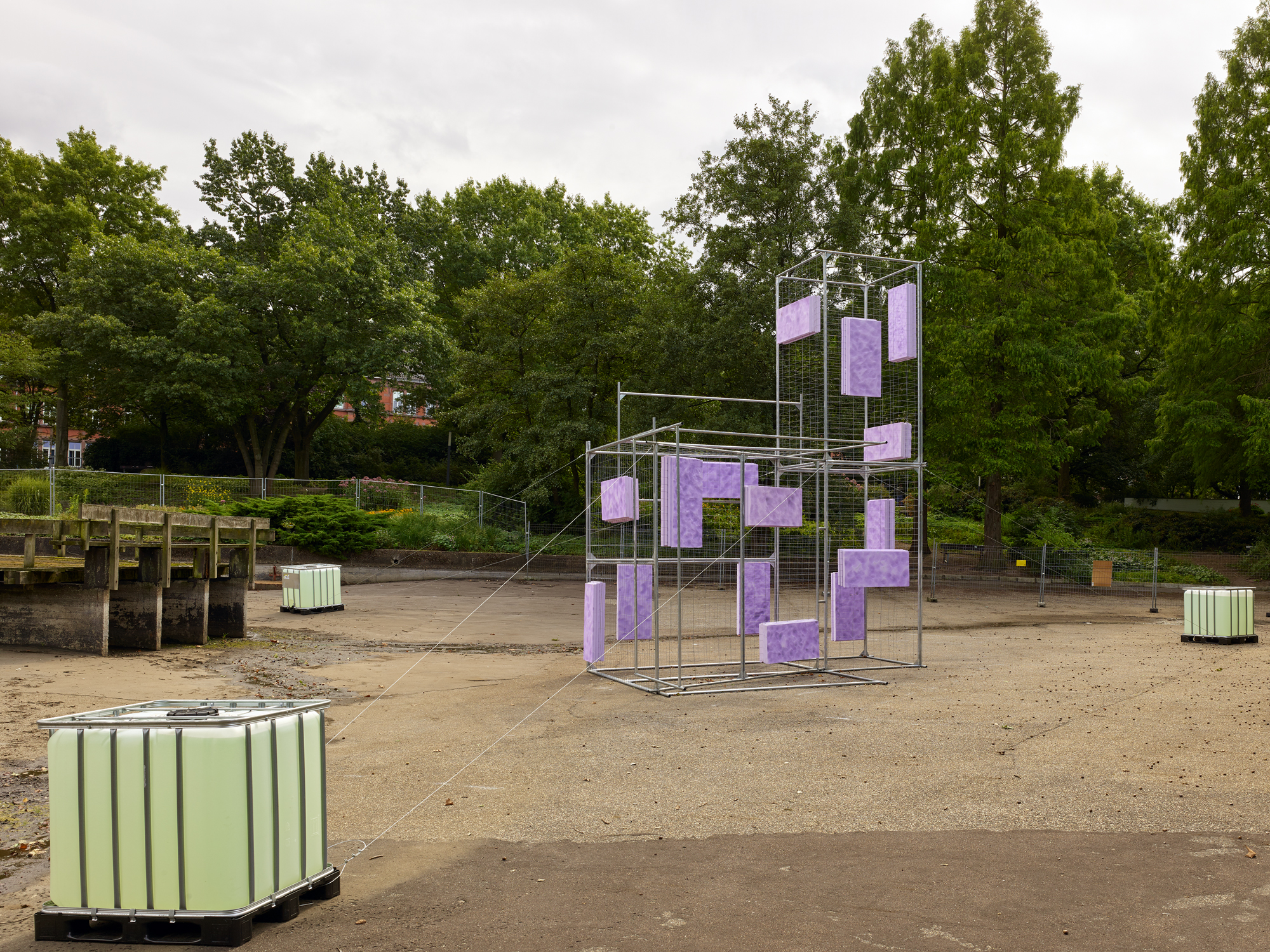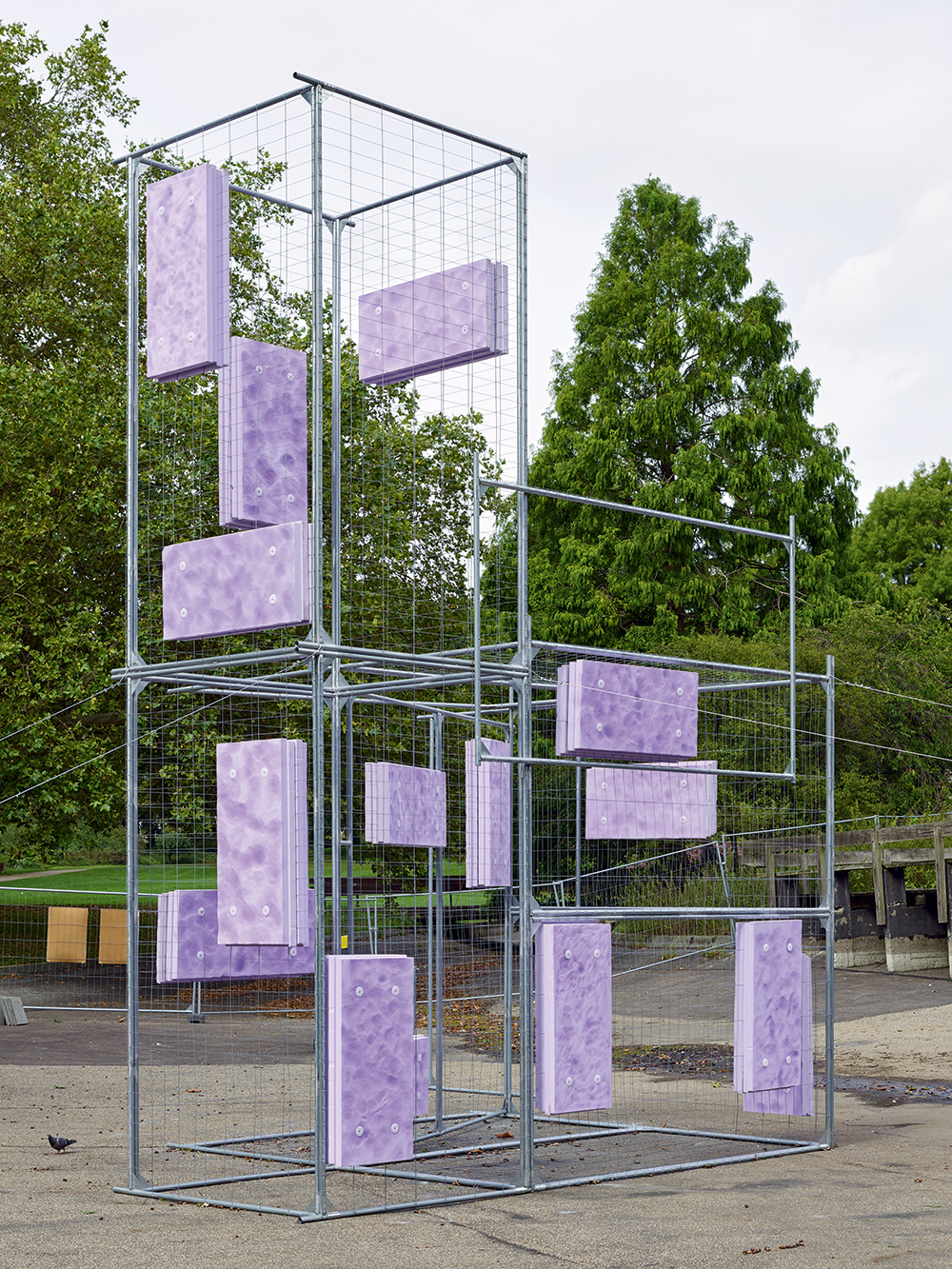



- 2006 Kunstverein St. Pauli
- 2010 Fischmarkt / Kunstverein St. Pauli
- 2016 »Parkplatztreffen« – Kunstverein St. Pauli
- 2012 »WER ZURÜCK BLEIBT WIRD ZURÜCK GELASSEN–Tour« – Kunstverein St. Pauli
- 2009 Artist book – Kunstverein St. Pauli
- 2023 Kunstverein St. Pauli »Praxis der Orte – ein Modellversuch«
- Related Work Next Project
»Cage Match« – Kunstverein St. Pauli
2019–2021
Planten un Blomen Hamburg
documentation Cage Match, 2019/20
Planten un Blomen, public park
Ein städtischer Park und eine Baustelle erscheinen auf den ersten Blick formal absolut gegensätzlich. Städtische Parks und im besonderen „Planten un Blomen" sind durch das Erleben von Natur bzw. deren Inszenierung sowie einer Fülle an Erholungs- und Freizeitangeboten attraktiv für alle Gesellschafts- und Altersschichten und ermöglichen dementsprechend ein gesellschaftliches Bild mit einem hohen Maß an unbestimmter Vielfalt und einem freien Mit- und Nebeneinander, wie es sonst nur selten im urbanen Raum zu finden ist. Dagegen sind Baustellen abgegrenzte Orte der Arbeit, die in der Regel im öffentliche Leben beispielsweise durch Lärm, Dreck oder Versperren als Störung wahrgenommen werden.
Wir möchten Baustellen hingegen als Lücken im Etablierten und als Unterbrechungen des Gewohnten behaupten, als Orte des Übergangs, des Unfertigen, des Werdens, als Orte die ihre Passanten zum Imaginieren einladen und somit in bestimmten Qualitäten auch Parks ähneln könnten. In den Kontrast zwischen Park und Baustelle am Teehaus positioniert sich Cage Match als Vermittlerin oder Übersetzerin, welche die Spannung der scheinbaren Gegensätze in künstlerischen Versuchen der Uminszenierung katalysiert.
Ausgangspunkt wird ein ca. 7 x 5 x 5 m großer, grob L-förmiger, transparenter Körper aus verschweißten Bauzäunen sein, der am Rand innerhalb der Baustelle positioniert wird. Partiell ist dieser offene aber käfigartige Körper mit violetten Styrodurplatten verkleidet, die ihn, neben Größe und Form, auch farblich gegenüber der Baustelle und dem Park hervortreten lassen, obwohl er sich auch gleichzeitig durch seine Transparenz und Materialität in beide integriert.
Sowohl Außen- als auch Innenseite dieses „cage“ bilden die Basis für die Interventionen von sieben eingeladenen KünstlerInnen/-gruppen, deren künstlerische Auseinandersetzung öffentliche Parks als Ort der Selbstbehauptung und Selbstbefragung nutzt, als eigene Baustellen und Transformationen des Subjektiven inszeniert bzw. zitiert.
Überdies dient die provisorische Architektur als Projektions Fläche für entsprechende Filmvorführungen, als Basis von musikalischen Events, Lesungen und Workshops und wird im Verlauf des Projektes mehrfach umgekippt, so dass wiederholt neue Ansichten des „cage“ entstehen, welche neben dem jeweiligen Projekt auch im Bezug auf den Park und der Baustelle sowie deren jeweilige Veränderungen gestaltet werden.
Gefördert durch die Bezirksversammlung, Bezirksamt Hamburg-Mitte und durch die Freie und Hansestadt Hamburg, Behörde für Kultur und Medien.
/
At first glance, an urban park and a construction site appear formally absolutely opposed. Urban parks and in particular "Planten un Blomen" are attractive for all social and age groups due to the experience of nature or its staging as well as an abundance of recreational and leisure offers and accordingly enable a social image with a high degree of indeterminate diversity and a free co-existence and coexistence that is otherwise rarely found in urban space. In contrast, construction sites are demarcated places of work that are usually perceived as a disturbance in public life due to noise, dirt, or obstructions, for example.
In contrast, we would like to assert construction sites as gaps in the established and as interruptions of the familiar, as places of transition, of the unfinished, of becoming, as places that invite their passers-by to imagine and thus could also resemble parks in certain qualities. In the contrast between park and construction site at the teahouse, Cage Match positions itself as mediator or translator, catalyzing the tension of apparent opposites in artistic attempts at restaging.
The point of departure will be a roughly L-shaped transparent body of welded construction fencing measuring approximately 7 x 5 x 5 meters, positioned at the edge within the construction site. Partially, this open but cage-like body is clad in purple Styrodur panels, which, in addition to size and shape, make it stand out in color against the construction site and the park, although it also simultaneously integrates with both through its transparency and materiality.
Both the outside and the inside of this "cage" form the basis for the interventions of seven invited artists/groups, whose artistic explorations use public parks as sites of self-assertion and self-questioning, staging or citing them as their own construction sites and transformations of the subjective.
Moreover, the provisional architecture serves as a projection surface for corresponding film screenings, as a basis for musical events, readings and workshops, and will be turned over several times in the course of the project, so that new views of the "cage" will repeatedly emerge, which, in addition to the respective project, will also be designed in relation to the park and the construction site as well as their respective changes.
Funded by the District Assembly, District Office Hamburg-Mitte and by the Free and Hanseatic City of Hamburg, Department for Culture and Media.
NO FUTURE Komplex / MUSS STERBEN“
ab Samstag 19.07.2020
Fotos: Felix Krebs, Malte Struck